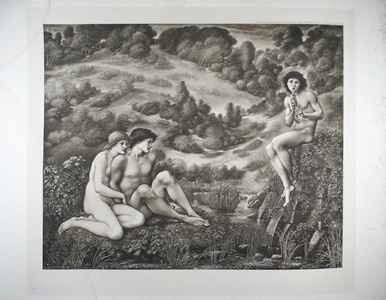| Method | Photogravure |
| Artist | after Sir Edward Coley Burne-Jones |
| Published | Published by the Berlin Photographic Company Berlin. _ London W.133 New Bond Street. _ New York 14 East 23rd Street. [c.1900] |
| Dimensions | Image 370 x 461 mm, Plate 441 x 517 mm, Sheet 507 x 667 mm |
| Notes |
Printed on India laid paper. Plate 86, taken from Burne-Jones' 1886-7 oil painting of the same title, from 'The Work of Edward Burne-Jones, Ninety-One Photogravures Directly Reproduced from the Original Paintings'. Only two-hundred copies of the 'The Work of Edward Burne-Jones...' were produced, each of which was signed by Philip Burne-Jones, the eldest son of Edward. Burne-Jones' 'The Garden of Pan' was conceived during a period in which he was deeply influenced by his travels to Italy. Having returned home in 1872, Burne-Jones intended to complete four ambitious works, none of which were ever fully realised. 'The Garden of Pan', although a completed work, belonged to this programme. As is told in Burne-Jones' memorial, written by his wife, Georgiana, Burne-Jones originally planned for the work to depict 'the beginning of the world - with Pan and Echo and sylvan gods, and a forest of centaurs, and a wild background of woods, mountains, and rivers'. Instead, the completed work is far simpler. Set within a pastoral landscape, Pan plays his pipes to a shepherd and shepherdess. 'The Garden of Pan' presents with a distinct Renaissance influence, both in style and subject matter. The composition and landscape setting are reminiscent of the pastoral image that had became prevalent in Venetian Renaissance painting, whilst Burne-Jones' choice of Pan as his subject emerged from his interest in Renaissance literature. Burne-Jones had developed a particular interest in the transformation of classical myths, those of which reappeared in the Renaissance. Throughout the centuries, the Greek god, Pan, appeared in various forms, from 'the good shepherd' to a fiendish goat-legged creature. In Burne-Jones' portrayal, the figure of Pan is presented as an attractive, slender youth. The youthful depiction references the original design of the work, which Burne-Jones had intended to title 'The Youth of Pan'. As he sits upon a rock, gazing towards the viewer, Pan plays upon his pipes, with a young shepherd and shepherdess listening. A kingfisher and dragonflies, known for their speed, have been stopped by the beautiful sound of Pan's music. Running through the centre of the image is a small stream, not only emphasising the pastoral nature of the setting, but acting as a divide between Pan and the listeners, and therefore, the natural and supernatural worlds. The painting from which this photogravure was taken is now in the collection of the National Gallery of Victoria, Melbourne. Sir Edward Coley Burne-Jones, 1st Bt (1833-1898) was a painter and designer closely associated with the later phase of the Pre-Raphaelite movement. Burne-Jones met William Morris as an undergraduate of Exeter college, Oxford, whilst studying for a degree in theology. The pair went on to work very closely together on numerous decorative arts projects including stained glass windows, tapestries and illustrations. Originally intending to become a church minister, Burne-Jones never finished his degree, choosing instead to pursue an artistic career under the influence of Dante Gabriel Rossetti. Rossetti heavily inspired his early work, but by the 1860's his idiosyncratic style was beginning to develop. His mature work, however different in total effect, is rich in conscious echoes of Botticelli, Mantegna and other Italian masters of the Quattrocento. Thusly, Burne Jones' later paintings of classical and medieval subjects are some of the most iconic of the Pre-Raphaelite movement. He was at the height of his popularity during the 1880's, though his reputation began to decline with the onset of the Impressionists. He was created a baronet in 1894, when he formally hyphenated his name. The Berlin Photographic Company, (1880 - 1920; fl) or the Berlin Photographische Gesellschaft, was a German print publishers who specialised in photogravures after Old Masters and contemporary painters. High quality photographs were taken of the original works. The negatives were then exposed onto a gelatin covered copper plate, etched with acid, and printed in a similar fashion to an engraving. The main series of the Berlin Photographic Company's publications is kept together at Blythe House, West Kensington. Condition: Foxing and discolouration to margins, water stain to left edge and lower left corner of sheet, slightly affecting image. |
| Framing | unmounted |
| Price | £400.00 |
| Stock ID | 41643 |

